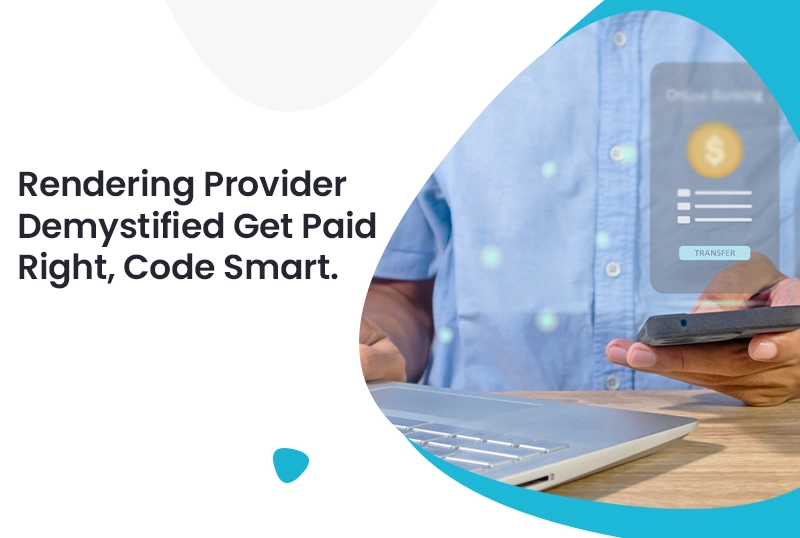Who exactly is the rendering provider on a claim? Why is it essential to get it right every time?
Therefore, it is really important for you to properly understand the basics involved and the technical difficulties while opting for medical billing service. It doesn’t really matter whether you are a solo practitioner or part of a large group. In case of opting for a medical billing service you need to ensure that they’re reporting the right provider details on every single claim.But even small errors in identifying or credentialing can result in big revenue consequences.
What Is a Rendering Provider?
The actual medical service being billed to insurance is performed by a rendering provider. Unlike the billing provider, which could be a clinic or group practice, the rending provider is the clinician who saw the patient and delivered the care.
You must list their NPI (National Provider Identifier) on the claim form to properly attribute the work and ensure reimbursement. At the same time, this role becomes especially critical in multi-provider or group practice settings, where different clinicians may be administering different services under the same billing entity. Furthermore, accurately identifying and reporting the rendering provider not only supports payer requirements but also ensures transparency, billing accuracy, and compliance with both state and federal regulations.
Key Facts:
- Must have a valid NPI (National Provider Identifier)
- Can be a physician, nurse practitioner, therapist, or any licensed practitioner
- It directly influences how payers review, approve, or deny claims.
- List it clearly on all CMS-1500 or electronic claims.
Types of rendering provider in medical billing:
- Physicians (MDs and DOs)
They deliver direct patient care, diagnoses, treatments, and procedures. You can bill them independently or under a group NPI. Also, it is one of the most common rendering providers in both inpatient and outpatient settings.
2. Nurse Practitioners (NPs) and Physician Assistants (PAs)
These medical experts perform many of the same clinical tasks as the physicians. They often serve as rendering providers in clinics, urgent care, and telehealth. Providers may bill services independently or under “incident-to” guidelines with supervising physicians.
3. Therapists (PT, OT, SLP)
The Physical, occupational, and speech-language pathologists are rendering providers for therapy services.They must meet state licensure and payer credentialing requirements.These services must be documented and tied to an approved plan of care.
4. Behavioral Health Providers
It includes psychologists, licensed clinical social workers (LCSWs), marriage and family therapists (MFTs), and counselors.They serve as rendering providers for mental health sessions and behavioral assessments. The payer recognition varies based on licensure and scope of practice
5. Chiropractors and Alternative Health Provider
They act as rendering providers for spinal manipulations, physical rehab, and wellness visits. The covered services depend on payer guidelines and medical necessity. It must meet specific documentation standards to be reimbursed.
6. Radiologists, Anesthesiologists, and Pathologists
Often function as rendering providers for diagnostic interpretations and procedural services. They typically work in facility-based or surgical environments. It requires precise linkage between services rendered and documentation.
Rendering Provider vs Billing Provider
Knowing the difference between the two is vital for proper claims submission.
Billing Provider:
- Entity or group submitting the claim
- Receives payment from the payer
- Can be a medical group, hospital, or solo practice
Rendering Provider:
- The individual clinician who provided the care
- Must be credentialed and enrolled with each payer
- Listed in Box 24J on the CMS-1500 form
Why the does it matter in Claim Success
Getting paid on time isn’t just about the services you deliver. It’s about how accurately they’re represented on the claim. Payers use their NPIs to validate credentialing status. Moreover, incorrect NPIs lead to claim rejections or delays. While on the other hand accurate reporting reduces audit risk and improves transparency. Rendering providers determine reimbursement eligibility for specific services.
Credentialing Requirements for a Rendering Provider
For a rendering provider to bill successfully, they must be credentialed with each insurance payer.
This is where professional credential services become extremely valuable. These services help keep provider records updated and in sync with payer systems, avoiding credentialing mismatches that lead to denials.
Important Tips for Credentialing Success:
- Confirm every rendering provider has an active NPI
- Maintain up-to-date CAQH profiles
- Ensure provider records are linked to the correct group NPI or tax ID
- Recredential every 2–3 years or per payer guidelines
A credentialing error is one of the top reasons claims with the correct CPT codes and documentation still get rejected.
When to Include a Rendering Provider on a Claim
Every claim submitted for a face-to-face encounter or direct clinical service must list the rendering provider.You should include the rendering provider when they personally deliver a procedure, exam, or consultation, if the service occurs in a clinic, private practice, or telehealth visit and if multiple providers work in the same group and the individual must be identified.
You may not need to contact them if the service is administrative or supply-based (e.g., lab processing without patient interaction) or the claim is solely for billing-level services without clinical contact.
Claim Submission Guidelines for the Rendering Provider
Below is a step by step guide on how to use Box 24J on the CMS-1500 form for the rendering provider’s NPI:
- Verify matching credentials between rendering and billing provider
- Use modifiers like -25 or -59 when necessary
- Confirm all services are supported by documentation
Accurate claim entry and clean pairing between provider and procedure reduce delays and rework.
impact of rendering provider:
- Determines correct CPT and modifier assignment
- Impacts place of service and billing level
- Influences whether services qualify for incident-to billing
- Supports audit-proof documentation by linking clinical work to the correct NPI
In specialties like surgery, behavioral health, or physical therapy, incorrect data can lead to mismatched codes and delayed payments—even if everything else is correct.
Final Thoughts: Why the Rendering Provider Can’t Be Overlooked
The rendering provider is not just a formality—it’s the foundation of accurate billing, proper credentialing, and reliable payment. By getting this right every time, your practice protects revenue, enhances claim accuracy, and improves overall compliance.
Whether you’re managing a solo office or working with multiple providers under one group, ensuring the rendering provider is clearly and correctly listed is a non-negotiable part of medical billing success.
FAQs About Rendering Providers
Q1: Can the rendering provider and billing provider be the same?
Yes, in solo practices where the same individual delivers care and submits the claim.
Q2: What if I forget to list the rendering provider?
The claim may be denied or returned by the payer for incomplete information.
Q3: Does the rendering provider need to be credentialed with every payer?
Absolutely. Failure to do so will likely result in denied or delayed payments.
Q4: How does this affect billing teams?
Billing staff must verify rendering provider credentials and NPIs for each payer before claim submission to avoid rejections.






